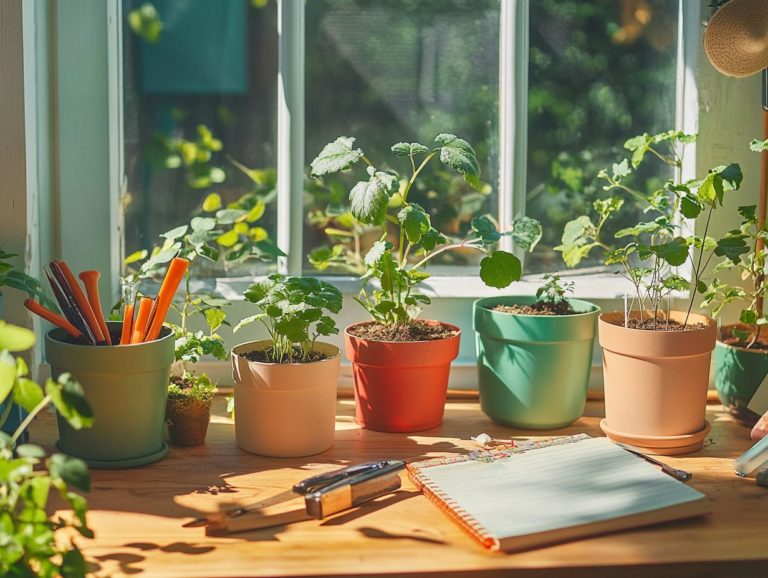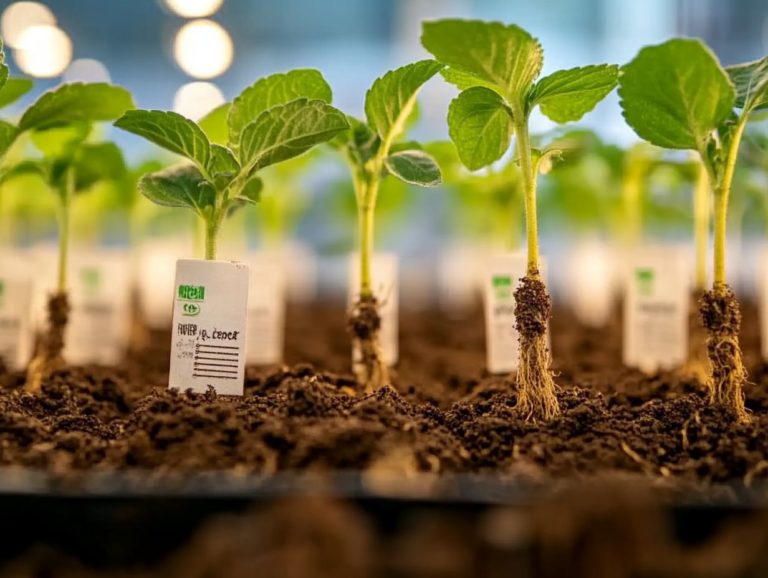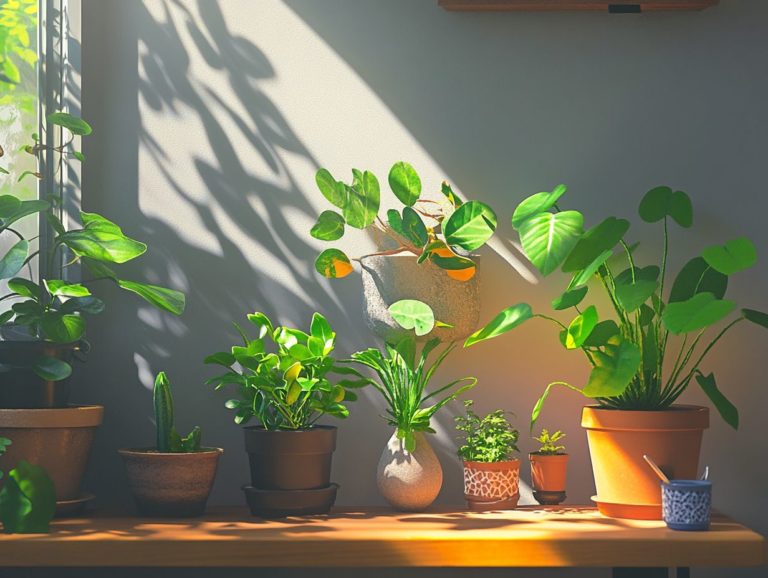The Fascinating World of Plant Propagation
Plant propagation offers a fascinating journey that reveals the remarkable ways in which plants reproduce and flourish.
You can explore various methods, from seeds to cuttings and even division, all designed to cultivate new life. By understanding the factors that influence propagation such as environment, genetics, and care practices you can enhance your gardening skills and ensure your success.
The benefits of propagation, including cost savings and the preservation of rare species, make it an essential practice for any plant enthusiast. Embrace this exploration of plant propagation and unlock the secrets to nurturing your green thumb.
Contents
Key Takeaways:
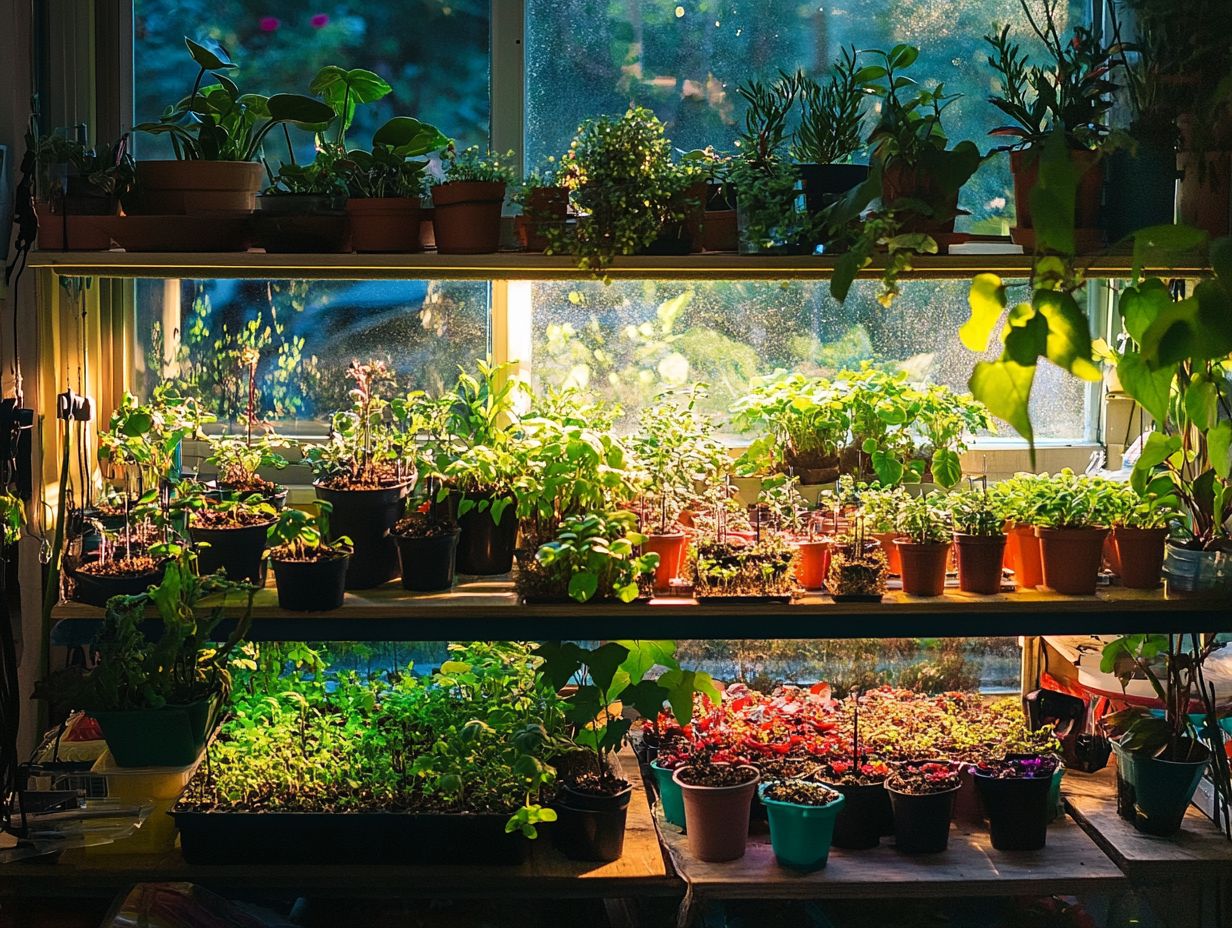
- Plant propagation creates new plants from existing ones.
- Methods include seeds, cuttings, division, and layering.
- Factors affecting success are environment, genetics, and care. Benefits include saving money and preserving rare species.
What is Plant Propagation?
Plant propagation is your gateway to creating new plants from the ones you already cherish. You can use various gardening techniques to expand your green collection.
This practice includes methods like taking cuttings, planting seeds, and even advanced techniques such as tissue culture, which is the process of growing plant cells in a controlled environment. These methods are fundamental to sustainable gardening.
By grasping the essentials of plant propagation, you nurture a healthy parent plant while enhancing your experience as a plant enthusiast or cultivator.
Mastering these techniques enhances your gardening skills. This allows you to increase biodiversity in your garden while ensuring your plants’ health and vigor remain intact.
Asexual propagation methods, like cuttings and division, yield quicker results, enabling you to multiply your favorite species swiftly. Seed propagation opens the door to cultivating new plant varieties, unlocking possibilities for unique garden designs.
By embracing these sustainable practices, you contribute to the conservation of endangered species. Plant propagation is an invaluable skill for hobbyists and professionals committed to environmental stewardship.
Methods of Plant Propagation
You have a variety of effective methods for plant propagation at your fingertips. Each method offers unique advantages tailored to your gardening journey.
Seed Propagation
Seed propagation is a fundamental method that involves planting seeds to create new plants. This method is essential for maintaining healthy plants and preserving heirloom varieties.
To embark on this rewarding journey, start by selecting seeds suited to your local climate and soil conditions. Choose seeds from reputable suppliers who offer organic or untreated options.
Once you have the perfect seeds, prepare a nutrient-rich seed-starting mix. This ensures proper drainage and aeration for your seedlings. Create small indentations in the soil, placing the seeds at the appropriate depth depending on their type. Lightly cover them with soil and provide gentle watering to avoid displacing them.
Boost your chances of successful germination by keeping a consistent temperature and moisture level. Using clear covers can help retain warmth and humidity, creating an ideal environment for sprouting.
Monitor your seedlings for any signs of pests or diseases. Ensure they receive adequate sunlight. With careful attention, you’ll see your plants thrive! Start your seed planting now and watch your garden grow!
Cutting Propagation
Cutting propagation is a technique you ll find incredibly effective. It involves the careful selection of stem cuttings from a healthy parent plant and nurturing them until they develop their own roots.
This method is the go-to for both novice and seasoned gardeners. It allows you to rapidly multiply your favorite plant varieties without the hassle of seeds. Start by selecting healthy stems that show no signs of disease or damage.
Once you’ve made your cut, applying a rooting hormone can be a game-changer. This product helps plants grow roots faster, stimulating robust root development.
Using propagation trays creates an ideal environment, ensuring proper drainage and ample space for growth. Remember, factors like humidity, temperature, and light are crucial in determining the success of your cuttings.
These factors help them thrive and establish a strong root system.
Division Propagation

Division propagation is a technique where you divide a mature plant into several sections, each boasting its own roots and shoots. This approach simplifies plant care and nurtures robust root development.
This method is perfect for hardy species such as perennials and certain houseplants. It enables you to propagate healthy, vigorous plants with ease.
By splitting the root ball, you encourage strong root systems that will flourish in their new environments. This process not only facilitates the cultivation of new plants but also revitalizes the parent plant.
It alleviates crowding and enhances overall health. This method is also less stressful for the plants, making it a top choice for gardeners.
Layering Propagation
Layering propagation is an intriguing method that encourages a branch to root while still connected to the parent plant. This allows you to create clones without cutting ties.
You ll want to start this technique right away in high humidity and consistent moisture. These conditions foster an ideal setting for root development.
The secret to successful layering lies in selecting robust branches and ensuring the right balance of light and nutrients. By employing layering propagation, you can efficiently replicate your favorite plants.
This ensures uniformity in their characteristics and resilience. This method becomes a valuable asset in your plant cloning toolkit, allowing you to preserve desirable traits while keeping genetic variation to a minimum.
Factors Affecting Plant Propagation
Several critical factors can profoundly impact the success of plant propagation. You’ll find that environmental conditions, along with genetic and cultural factors, play a crucial role in influencing growth and development.
Environmental Factors
- Temperature: Keeping temperatures between 70 F and 75 F fosters strong growth and minimizes the risk of disease.
- Humidity: Aim for humidity levels around 50% to 70%. Too much dryness can cause delicate cuttings or seedlings to dry out.
These environmental factors are pivotal to the success of your propagation techniques. They demand careful monitoring to achieve the best results.
By grasping these essential conditions, you can refine your techniques and ensure maximum efficiency. Boost your success rate in propagation endeavors.
Ready to expand your garden? Start using these propagation methods today and watch your plant collection flourish!
Genetic Factors
Genetic factors, including the unique characteristics of various plant species and heirloom varieties, can significantly influence your success in propagation and the techniques you choose to employ.
Understanding these genetic traits is vital when selecting which plants to propagate. Different varieties may demonstrate varying degrees of adaptability to diverse environmental conditions. For example, some species may flourish with straightforward cutting techniques, while others might require more intricate methods, such as joining two plant parts together to grow a new plant or layering, to promote healthy growth. For a deeper understanding, refer to the ultimate guide to successful plant propagation.
By thoughtfully selecting the right combination of genetic attributes, you can enhance your chances of successful propagation. This leads to robust plants that thrive in their ecosystems. This meticulous attention to genetic detail not only maximizes your yield but also contributes to preserving biodiversity, making informed choices essential for your long-term gardening success.
Cultural Factors

Cultural factors, including the knowledge and techniques employed by plant parents, greatly influence the challenges and success rates associated with various propagation methods.
Understanding local gardening traditions and the types of plants favored in your region is essential for nurturing your green companions effectively. Different communities have cultivated unique approaches to plant care, from utilizing indigenous fertilizers to adhering to specific watering schedules that align with seasonal climates.
These culturally-informed practices can lead to varying degrees of success in plant care and propagation. They often present unique obstacles to gardeners. Unfamiliarity with certain propagation techniques can complicate your journey as a plant parent.
Embracing both traditional wisdom and modern gardening techniques is vital for achieving optimal growth and sustainability with your plants.
Benefits of Plant Propagation
The benefits of plant propagation are extensive, offering you savings on acquiring new plants while playing a crucial role in preserving rare or endangered plant species.
By engaging in propagation, you not only enhance your gardening skills but also contribute meaningfully to sustainable practices that benefit the environment.
Start your propagation journey today! One of the most enticing advantages of plant propagation is the significant cost savings it offers you as a gardener, enabling you to cultivate vibrant, healthy plants without the constant need to purchase from garden centers. To learn more about this fascinating process, check out the science behind plant propagation.
By mastering techniques like cutting propagation, division, and layering, you can effortlessly expand your plant collection while substantially slashing expenses. For example, taking stem cuttings from a beloved shrub can yield numerous new plants in a fraction of the time and cost compared to buying them outright. Additionally, you’ll find that having the tools you need for plant propagation can make the process even smoother. Dividing root clumps from mature perennials not only enhances your garden’s biodiversity but also supports sustainable practices by reducing waste.
These methods promote financial savings and provide an enriching way to connect with nature, deepening your understanding of horticulture and the ecological advantages of nurturing plants responsibly.
Preserving Rare or Endangered Plants
Plant propagation is essential for preserving rare and endangered plant species, ensuring their survival through effective techniques and sustainable gardening practices. This need becomes even more pressing as habitat loss and climate change continue to threaten biodiversity, leading to various propagation challenges.
Techniques like seed propagation where seeds are collected, dried, and stored for future planting act as a safeguard against extinction. Additionally, cloning methods, such as tissue culture, facilitate the rapid multiplication of unique specimens without disrupting their natural habitats. By cultivating native plants in your home garden, you not only support local ecosystems but also enhance the genetic diversity of rare species. Understanding the life cycle of propagated plants can further enrich your gardening practices.
By employing these methods, you can contribute to fostering resilience among plant populations, ultimately helping to maintain the harmony of ecosystems.
Watch the video to learn more about effective plant propagation techniques!
Frequently Asked Questions
Consider adding your questions here for more insights and guidance on plant propagation.
What is plant propagation?
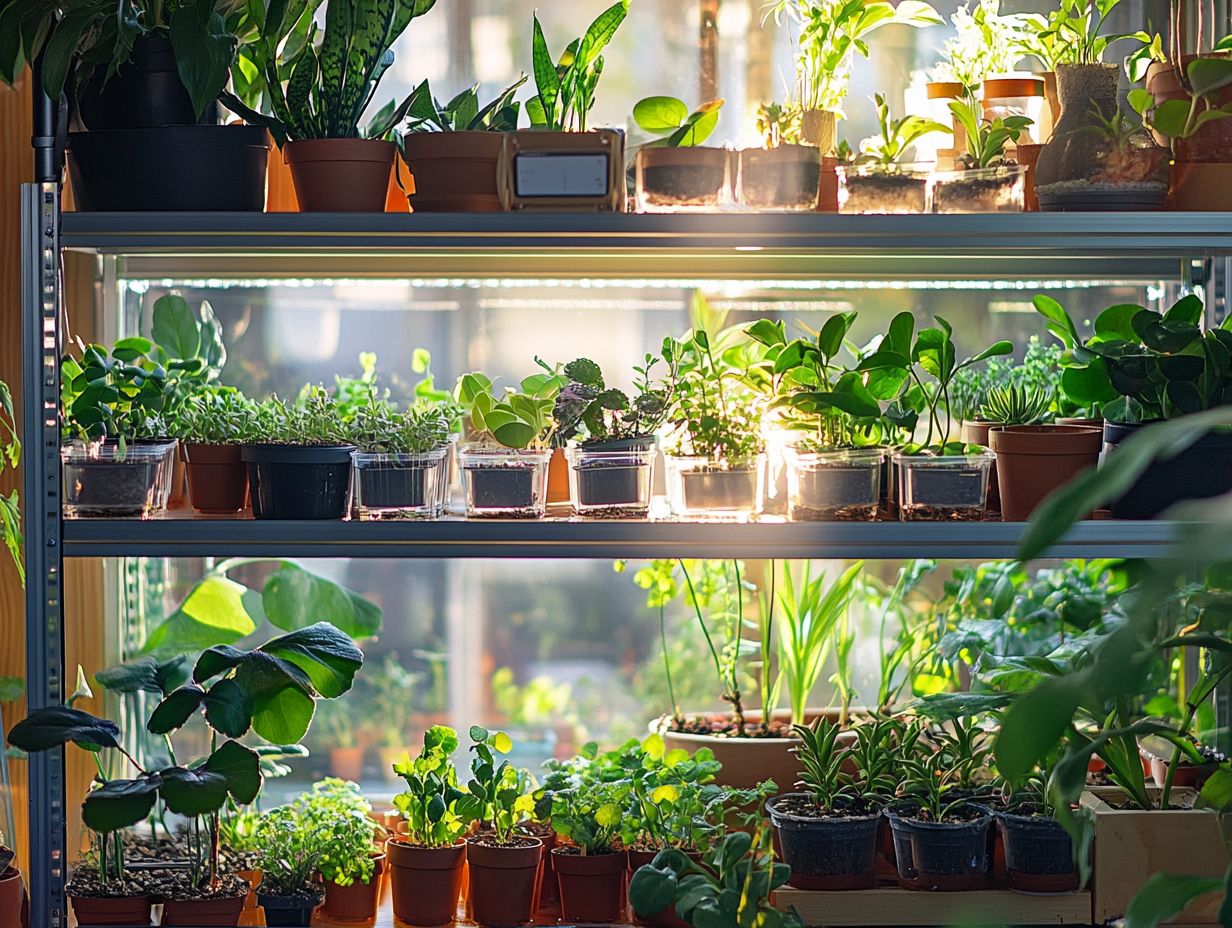
Plant propagation creates new plants from existing ones. This can happen either sexually or asexually through methods like seeds, cuttings, and grafting.
Why is plant propagation important?
Plant propagation expands the plant population and creates new varieties. It also helps reproduce plants that are hard to grow from seeds.
What are the different methods of plant propagation?
Methods of plant propagation include seed propagation, stem cutting, division, layering, and grafting. Each method offers unique advantages for different plants.
What are the benefits of asexual plant propagation?
Asexual propagation, such as stem cutting and division, produces genetically identical plants. This guarantees new plants inherit the desirable traits of the parent plant.
Can all plants be propagated?
Most plants can be propagated, but not all methods work for every plant. Some may be difficult to propagate, while others thrive only with specific techniques.
How do I get started with plant propagation?
Ready to dive into plant propagation? Discover the best methods for your plants and arm yourself with the right tools and care knowledge!


